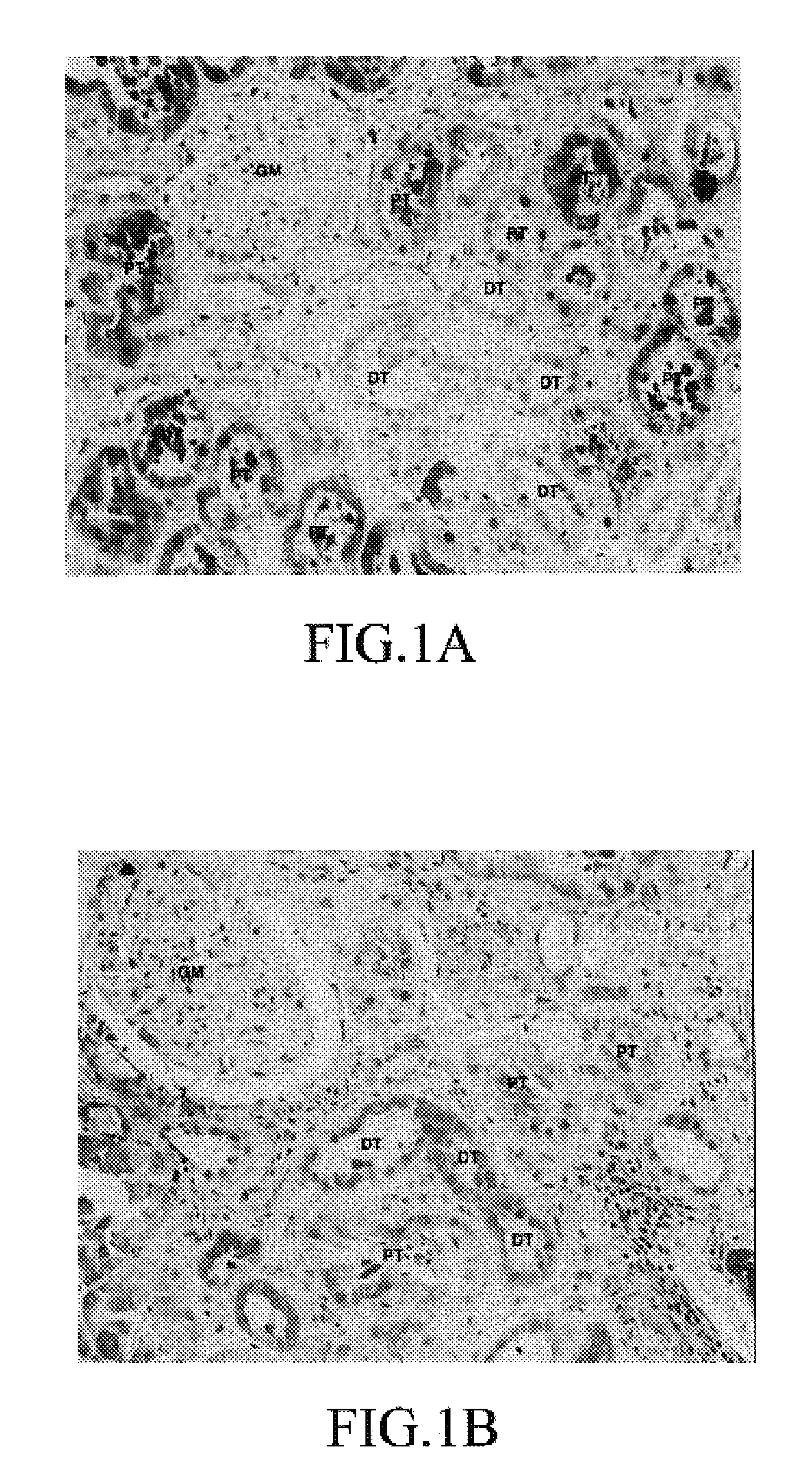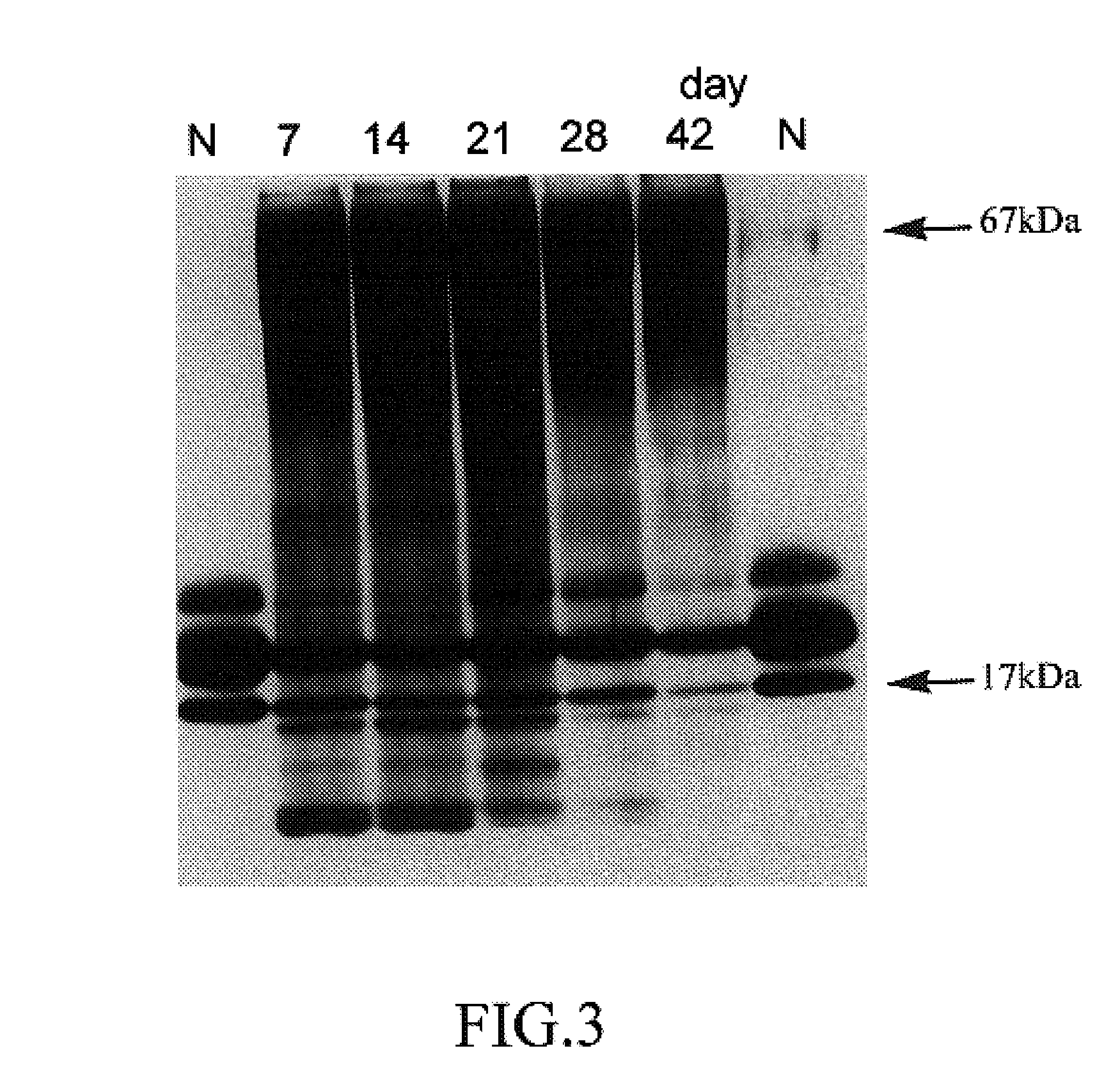Method for examining human kidney disease by detecting the fatty acid binding protein
a technology of fatty acid binding protein and kidney disease, which is applied in the field of examination, can solve the problems of not being able to establish a decisive method for accurate diagnosis of the prognosis of kidney disease, and aiming at the existence of kidney disease in the tissues, and achieve the effect of diagnosing kidney diseas
- Summary
- Abstract
- Description
- Claims
- Application Information
AI Technical Summary
Benefits of technology
Problems solved by technology
Method used
Image
Examples
example 1
Preparation (I) of Antibody Binding to FABP in Human Kidney Tissue (Preparation of Anti-Mouse FABP Antibody)
(1) Anti-Mouse L-FABP Polyclonal Antibody:
[0060]FABP existing at the human proximal tubule has been known to be mainly a liver-type FABP (L-FABP). Human L-FABP and mouse L-FABP have a high homology, and as an antibody binding to L-FABP in human kidney tissues, anti-mouse L-FABP antibody may be used.
[0061]Thus, an anti-mouse L-FABP polyclonal antibody was prepared. The antigen, mouse L-FABP, was prepared according to the method disclosed in the literature (Takahashi et al., Eur. J. Biochem., vol. 136, p. 589-601, 1983), as follows. That is, to the excised liver from a mouse killed by bleeding was added a four-time volume of 30 mM Tris-HCl buffer (pH 8), and the mixture was treated by a polythoron-type homogenizer. The resultant was centrifuged at 8000 rpm for 15 minutes, and the supernatant thus obtained was further ultra-centrifuged at 100,000×g for 90 minutes to give the cyto...
example 2
Preparation (II) of Antibody Binding to FABP in Human Kidney Tissues (Preparation of Anti-Human L-FABP Antibody)
(1) Purification of recombinant human L-FABP:
[0065]cDNA of human L-FABP was obtained by PCR (polymerase chain reaction) from the cDNA library derived from human liver (manufactured by CLONTECH Laboratories Inc., Cat # HL1115b Lot # 5621). An oligonucleotide of 23 to 27mers synthesized by a DNA synthesizer was used as a primer. The nucleotide sequence of the primer was designed based on the gene sequence of human L-FABP disclosed in the literature (Lowe et al., J. Biol. Chem., vol. 260, p. 3413-3417, 1985) and Gene Data Base (GENBANK Accession No. M10617), with adding a restriction enzyme recognition site for inserting an expression vector at the end of the primer. The obtained DNA fragment (about 420 base pairs) has a BamHI recognition site before the initiation codon, and the BamHI recognition site after the termination codon, and encodes the desired full-length human L-F...
example 3
Localization of FABP in Human Kidney Tissues (Normal Kidney Tissues)
[0071]Normal human kidney tissues were subjected to immunohisto staining of FABP. The human kidney tissues were normal portions of the kidney excised from the patient with renal cancer. A primary antibody for L-FABP staining was the anti-mouse L-FABP polyclonal antibody (IgG) prepared in the same manner as in Example 1-(1). A primary antibody for H-FABP staining was the anti-mouse H-FABP polyclonal antibody (IgG) prepared in the same manner as in Example 1-(2). The immunostaining was carried out using Vectastain ABC kit (manufactured by Vector Laboratory, Inc.), and a secondary antibody was a biotinylated anti-rabbit IgG, and an enzyme was a biotinylated horseradish peroxidase, and a coloring substrate was DAB (3,3′-diaminobensidine tetrahydrochloride).
[0072]The results are shown in FIG. 1. When anti-L-FABP antibody was used, the proximal tubule was stained. On the other hand, when anti-H-FABP antibody was used, the...
PUM
| Property | Measurement | Unit |
|---|---|---|
| molecular weight | aaaaa | aaaaa |
| excitation wavelength | aaaaa | aaaaa |
| pH | aaaaa | aaaaa |
Abstract
Description
Claims
Application Information
 Login to View More
Login to View More - R&D
- Intellectual Property
- Life Sciences
- Materials
- Tech Scout
- Unparalleled Data Quality
- Higher Quality Content
- 60% Fewer Hallucinations
Browse by: Latest US Patents, China's latest patents, Technical Efficacy Thesaurus, Application Domain, Technology Topic, Popular Technical Reports.
© 2025 PatSnap. All rights reserved.Legal|Privacy policy|Modern Slavery Act Transparency Statement|Sitemap|About US| Contact US: help@patsnap.com



